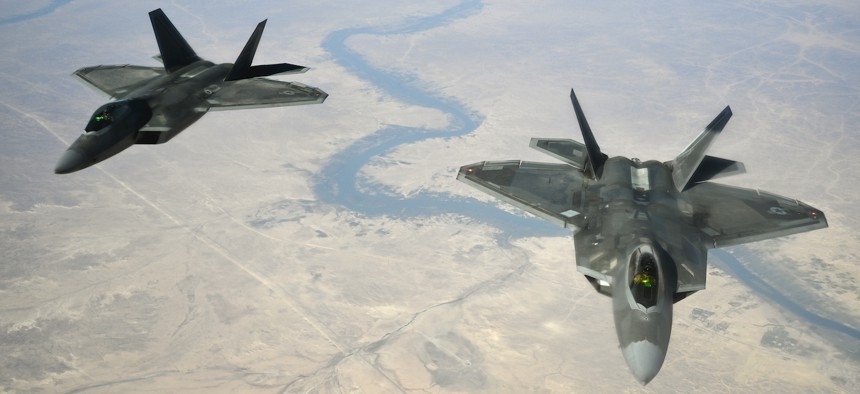
U.S. Air Force F-22 Raptors fly in formation behind a 28th Expeditionary Air Refueling Squadron KC-135 Stratotanker during a combat air patrol mission, Nov. 15, 2019. (U.S. Air Force photo by Master Sgt. Joshua L. DeMotts
Toward a War With Fewer Radio Calls
A recent Air Force test that data-linked an F-35 and an F-22 promises to move and combine data automatically.
The biggest change in the way the United States wages war over the next decade may be a lot more action and a lot fewer radio calls. A recent test that connected the computers of two stealthy Air Force aircraft — an F-22 Raptor and an F-35 Joint Strike Fighter — allowed them to share data automatically, so that their pilots can spend less time talking to each other and more time assessing the data and acting on it.
It’s part of a plan to digitally stitch together virtually everything on the battlefield, allowing data to move quickly and seamlessly between jets, drones, ships and soldiers via a massive interconnected digital architecture called the Advanced Battle Management System, or ABMS.
The 5th-generation fighters transferred only a small amount of data in the December test, which was conducted with U.S. Northern Command, or NORTHCOM, William Roper, assistant Air Force secretary for acquisition, technology, and logistics, told reporters on Tuesday. But Roper said the test nonetheless marks a milestone in a multi-year transformation.
“One of the things that [NORTHCOM Commander Gen. Terrence John O'Shaughnessy] did that was a real eye-opener for me in this NORTHCOM example is went through… the sequence of phone calls that have to happen today for decisions; so many people in between information, moving between different nodes in the decision chain,” said Roper. “The idea with the advanced battle management system is that the people are no-longer the glue. The information flows everywhere all at once and the people are the assessors, the analyzers, the feedback providers that help the analytics doing the pushing get better and better.”
The Air Force hopes to start running similar tests every four months. The next one, scheduled for April, will incorporate the experimental Skyborg drone as well as elements from U.S. Strategic Command, or STRATCOM.
That’s a very fast timescale for experimentation, at least traditionally. But the point of the effort is really to create new interlinks between weapons, vehicles, or nodes that already exist.
Creating those interlinks is a lot more difficult than just writing kluge code. Those various jets, computers, radios, and such weren’t designed to talk to each other. In fact, the F-22 and the F-35 use two different tactical datalink languages. In the case of the gateway, Air Force Chief Architect Preston Dunlap said, “We took a radio system that was built in concert with Northrop Grumman and then Lockheed Martin to be able to deal with both platforms and both waveforms and then a Honeywell antenna that was able to speak across the frequency of both radio systems.”
The test also showed that they could incorporate satellite data from a commercial low-earth orbit satellite (Starlink from SpaceX) into an AC-130 plane. It used the Air Force’s CloudOne (a hybrid AWS and Microsoft cloud) for battle management and command and control.
The Air Force envisions the Advanced Battle Management System having six distinct categories of products (and 28 product lines) as represented by this list. They include everything from next-generation software-defined radio, mesh networks, secure datalinks and cloud capability to artificially intelligent software that can figure out what data analysts and operators need to see and the best way to get it to the right destination.
The latter is key to fighting faster and getting ahead of the adversary's decision-making cycle, said Roper.
“In the case of a cruise missile, you can imagine that being the type of threat that computer vision could nail very well. It’s very specific. It’s a thin, narrow threat, flying at speeds that something wouldn’t fly at in any commercial domestic or use case. Computer vision should nail that that’s a cruise missile with a very high degree of accuracy. Until that digital backbone is there, we’re going to be asking people to figure it out by making phone calls,” he said.
The end result will be much faster and more accurate operations without lots of new pieces of expensive hardware. Roper said that the appetite among operators and senior leaders was robust. “We could not have a bigger push from the operators. [Senior leaders have determined that] the things between systems are now more important than the systems themselves, just like the thing behind your smartphone is really more important than the phone you carry.”
NEXT STORY: Pentagon Wants to Build One Satellite Per Week




